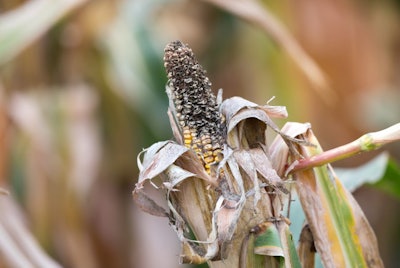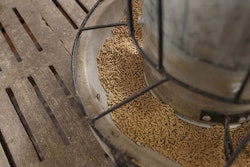
Warm, wet weather causing fungal diseases across the Corn Belt
Warm, wet weather throughout the 2019 growing season is causing fungal diseases in corn across the U.S. Corn Belt.
Ear rot, stalk rot, tar spot and mycotoxins are among the many concerns for corn farmers.
Scientists at the University of Kentucky are warning about two kinds of ear rot: diplodia and fusarium.
Warm and wet weather causes diplodia ear rot in corn. The disease is identified by fluffy white mold between the kernels. It can cause major storage problems if the affected corn is not dried and conditioned properly, and may decrease test weight and kernel size, which affect feed quality and yield. When conditions for the diplodia ear rot occur, added pressure may come from insect damage, leading to the potential for mycotoxin growth.
Fusarium ear rot infects corn after pollination, particularly in warmer temperatures. Fusarium-infected ears may have white to purple fungal growth on the cob, or symptoms may appear as discolored kernels scattered throughout a cob or associated with insect feeding. Visible fungal growth may not be obvious on the cob, but a white “starburst” pattern in kernels can sometimes be observed on ears infected by this fungus.
According to the University of Kentucky Grain and Forage Center of Excellence at Princeton, if ear rots are observed in a field, affected areas should be harvested early and grain segregated to avoid contamination of non-infected grain. Grain harvested with suspected ear rots should be dried to below 15% moisture. If the grain is stored above this moisture content, mold can continue to grow, and any mycotoxins present can continue to accumulate in grain. All grain contaminated by any ear rot fungus should be stored separately from good grain, and if stored long term, it should be stored below 13% moisture to prevent further growth of fungi.
Stalk rot, tar spot
Iowa State University field agronomist Meaghan Anderson said farmers should also be on the lookout for stalk rot, and that fields at risk of stalk rot should be prioritized at harvest.
“If I’m thinking pre-harvest in our crop fields, the thing that I would be concerned about and keeping a close eye on would be our corn,” she said. “We may be seeing more stalk rot happening, especially with some thinner stalks out in our crop fields.”
In addition, Anderson said this year’s crop is also at risk for tar spot, which causes small, raised, black, irregular-shaped spots on the leaves of corn plants. The spots are fungal fruiting bodies that release spores to infect the plant, reducing yield by 10-50%.
According to Iowa State University: “As with most diseases, tar spot does have ‘look-a-likes’ – namely, common and southern rust. At the end of the growing season, both rust fungi switch from producing orange-red uredinospores, to black teliospores. Rust pustules filled with teliospores can be mistaken for tar spot ascomata. Remember that rust spores burst through the epidermis and the spores can be scraped away from the pustules with a fingernail. Tar spots cannot be scraped off the leaf tissue.”














